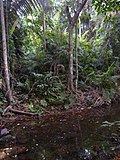Jungle
Jungle is a term that refers to land covered with dense vegetation dominated by trees. The term has been derived from the Sanskrit word jangala which means "uncultivated land". Although the term jungle is often associated with tropical rainforests, it is also applicable to other types of terrain where the vegetation is dense.
Etymology[edit]
The word jungle originates from the Sanskrit word jangala (जंगल), which means "wild" or "forest". The term was first used in English in the 18th century.
Characteristics[edit]
Jungles are often characterized by dense, tangled and impenetrable vegetation, typically lush with large trees. These ecosystems are also extremely rich in biodiversity, hosting numerous species of plants and animals.
Types of Jungles[edit]
There are several types of jungles, including:
- Tropical Rainforest: These are the most common type of jungle, found near the equator. They are characterized by high rainfall and a warm climate year-round.
- Temperate Rainforest: These jungles are found in cooler climates, and have less biodiversity than tropical rainforests.
- Mangrove Forests: These jungles grow in coastal saline or brackish water, mainly in the tropics and subtropics.
Flora and Fauna[edit]
Jungles are home to a wide variety of flora and fauna. This includes numerous species of trees, plants, birds, reptiles, insects, and mammals. Some of the most notable species include the jaguar, orangutan, and toucan.
Threats and Conservation[edit]
Jungles are under threat from various human activities, including deforestation, logging, and urbanization. Conservation efforts are being made to protect these vital ecosystems, including the establishment of national parks and wildlife reserves.
See Also[edit]
Ad. Transform your life with W8MD's Budget GLP-1 injections from $75


W8MD offers a medical weight loss program to lose weight in Philadelphia. Our physician-supervised medical weight loss provides:
- Weight loss injections in NYC (generic and brand names):
- Zepbound / Mounjaro, Wegovy / Ozempic, Saxenda
- Most insurances accepted or discounted self-pay rates. We will obtain insurance prior authorizations if needed.
- Generic GLP1 weight loss injections from $75 for the starting dose.
- Also offer prescription weight loss medications including Phentermine, Qsymia, Diethylpropion, Contrave etc.
NYC weight loss doctor appointmentsNYC weight loss doctor appointments
Start your NYC weight loss journey today at our NYC medical weight loss and Philadelphia medical weight loss clinics.
- Call 718-946-5500 to lose weight in NYC or for medical weight loss in Philadelphia 215-676-2334.
- Tags:NYC medical weight loss, Philadelphia lose weight Zepbound NYC, Budget GLP1 weight loss injections, Wegovy Philadelphia, Wegovy NYC, Philadelphia medical weight loss, Brookly weight loss and Wegovy NYC
|
WikiMD's Wellness Encyclopedia |
| Let Food Be Thy Medicine Medicine Thy Food - Hippocrates |
Medical Disclaimer: WikiMD is not a substitute for professional medical advice. The information on WikiMD is provided as an information resource only, may be incorrect, outdated or misleading, and is not to be used or relied on for any diagnostic or treatment purposes. Please consult your health care provider before making any healthcare decisions or for guidance about a specific medical condition. WikiMD expressly disclaims responsibility, and shall have no liability, for any damages, loss, injury, or liability whatsoever suffered as a result of your reliance on the information contained in this site. By visiting this site you agree to the foregoing terms and conditions, which may from time to time be changed or supplemented by WikiMD. If you do not agree to the foregoing terms and conditions, you should not enter or use this site. See full disclaimer.
Credits:Most images are courtesy of Wikimedia commons, and templates, categories Wikipedia, licensed under CC BY SA or similar.
Translate this page: - East Asian
中文,
日本,
한국어,
South Asian
हिन्दी,
தமிழ்,
తెలుగు,
Urdu,
ಕನ್ನಡ,
Southeast Asian
Indonesian,
Vietnamese,
Thai,
မြန်မာဘာသာ,
বাংলা
European
español,
Deutsch,
français,
Greek,
português do Brasil,
polski,
română,
русский,
Nederlands,
norsk,
svenska,
suomi,
Italian
Middle Eastern & African
عربى,
Turkish,
Persian,
Hebrew,
Afrikaans,
isiZulu,
Kiswahili,
Other
Bulgarian,
Hungarian,
Czech,
Swedish,
മലയാളം,
मराठी,
ਪੰਜਾਬੀ,
ગુજરાતી,
Portuguese,
Ukrainian









